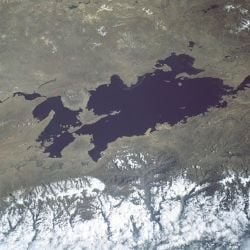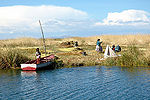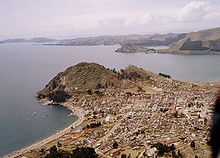Lake Titicaca
| Lake Titicaca | |
|---|---|
| Coordinates | |
| Lake type | Mountain Lake |
| Primary sources | 27 rivers |
| Primary outflows | Desaguadero River Evaporation |
| Catchment area | 58,000 km² |
| Basin countries | Peru Bolivia |
| Max length | 190 km |
| Max width | 80 km |
| Surface area | 8,372 km² |
| Average depth | 107m |
| Max depth | 281m |
| Water volume | 893 km³ |
| Shore length1 | 1,125 km |
| Surface elevation | 3,812 m |
| Islands | 42+ islands See Article |
| Settlements | Puno, Peru Copacabana, Bolivia |
| 1 Shore length is an imprecise measure which may not be standardized for this article. | |
Lake Titicaca is the highest commercially navigable lake in the world,[1] at 3,812 m (12,507 feet) above sea level. Located in the Altiplano high in the Andes on the border of Peru and Bolivia, Titicaca has an average depth of 107 m,[2] and a maximum depth of 281 m. The western part of the lake belongs to the Puno Region of Peru, and the eastern side is located in the Bolivian La Paz Department. The Bolivian naval force uses the lake to carry out exercises, maintaining an active navy despite being landlocked.
The partly salt Lake Maracaibo in Venezuela is the only body of water in South America bigger than Titicaca, at about 13,000 square kilometers, but some say it should be classified as a sea because it is connected to the ocean.
The origin of the name Titicaca is unknown. It has been translated as "Rock Puma," allegedly because of its resemblance to the shape of a puma hunting a rabbit, combining words from the local languages Quechua and Aymara. It has also been translated as "Crag of Lead." Locally, the lake goes by several names. Because the southeast quarter of the lake is separate from the main body (connected only by the Strait of Tiquina), the Bolivians call it Lago Huiñaymarca and the larger part Lago Chucuito. In Peru, these smaller and larger parts are referred to as Lago Pequeño and Lago Grande, respectively.
Geography
More than twenty-five rivers empty into Titicaca, and the lake has forty-one islands, some of which are densely populated.
Titicaca is fed by rainfall and meltwater from glaciers on the sierras that abut the Altiplano. It is drained by the Desaguadero River, which flows south through Bolivia to Lake Poopó. This accounts for less than 5 percent of the lake's water loss, however, the rest is caused by evaporation as a result of the strong winds and sunlight at this altitude. One small river, the Desaguadero, drains the lake at its southern end. This single outlet empties only 5 percent of the lake's excess water; the rest is lost by evaporation under the fierce sun and strong winds of the dry Altiplano.
Titicaca's level fluctuates seasonally and over a cycle of years. During the rainy season (summer, from December to March) the level of the lake rises, normally to recede during the dry winter months. It was formerly believed that Titicaca was slowly drying up, but modern studies have seemed to refute this, indicating a more or less regular cycle of rise and fall.
Titicaca's waters are limpid and only slightly brackish, with salinity ranging from 5.2 to 5.5 parts per 1,000. Surface temperatures average 56º F (14º C); from a thermocline at 66 feet (20 m) temperatures drop to 52º F (11º C) at the bottom. Analyses show measurable quantities of sodium chloride, sodium sulfate, calcium sulfate, and magnesium sulfate in the water.
Titicaca (Stone Puma) has lived a long life of millions of years. It contains the sum of all the ages that have molded and defined the works that humans have undertaken in the southern Americas. Over this span of time, that reaches back some two million years, its body of water has been much larger, and encompassed areas today covered in salt flats and wasteland.
Lake Titicaca's fish life consists principally of two species of killifish (Orestias)—a small fish, usually striped or barred with black—and a catfish (Trichomycterus). In 1939, and subsequently, trout were introduced into Titicaca. A large frog (Telmatobius), which may reach a length of nearly a foot, inhabits the shallower regions of the lake.
Islands
Uros
Titicaca is notable for a population of people who live on the Uros, a group of about 43 artificial islands made of floating reeds. Their original purpose was defensive, and they could be moved if a threat arose. One of the islands retains a watchtower largely constructed of reeds. These islands have become a major tourist attraction for Peru, drawing excursions from the lakeside city of Puno.
Amantaní
Amantaní is another small island in Lake Titicaca populated by Quechua speakers. About eight hundred families live in six villages on the basically circular 15-square-kilometer island. There are two mountain peaks, called Pachatata (Father Earth) and Pachamama (Mother Earth), and ancient ruins on the top of both peaks. The hillsides that rise up from the lake are terraced and planted with wheat, potatoes, and vegetables. Most of the small fields are worked by hand. Long stone fences divide the fields, and cattle, sheep, and alpacas graze on the hillsides.
There are no cars on the island, and no hotels. A few small stores sell basic goods, and there is a health clinic and school. Electricity is produced by a generator and limited to a couple of hours each day.
Some of the families on Amantaní open their homes to tourists for overnight stays and provide cooked meals, arranged through tour guides. The families who do so are required to have a special room set aside for the tourists and must fit a code by the tour companies that help them. Guests typically take food staples (cooking oil, rice, sugar) as a gift or school supplies for the children on the island. They hold nightly traditional dance shows for the tourists and offer to dress them up in their traditional clothes and participate.
Isla del Sol
Situated on the Bolivian side of the lake with regular boat links to the Bolivian town of Copacabana, Isla del Sol ("Island of the Sun") is one of the lake's largest islands. In Inca mythology it figured as the place of their origin, and several important Inca ruins exist on the island. Its economy is mainly driven by tourism revenues, but subsistence agriculture and fishing are widely practiced.
An underwater archaeological research project was undertaken off the Island of the Sun during 1989-1992. Rare Inca and Tiahuanaco artifacts were recovered, which are currently on display in a site museum in Challapampa.[3]
History
The ruins of an ancient temple have been found by international archaeologists under Lake Titicaca, the world's highest lake.
map A terrace for crops, a long road and an 800-metre (2,600 feet) long wall was also found under the waters of the lake, sited in the Andes mountains between Bolivia and Peru.
Dating back 1,000 to 1,500 years ago, the ruins are pre-Incan.
They have been attributed to the indigenous Tiwanaku or Tiahuanaco people, said Lorenzo Epis, the Italian scientist leading the Atahuallpa 2000 scientific expedition.
The holy temple measures 200m by 50m (660ft by 160ft) almost twice the size of an average football pitch.
More than 200 dives were made into the lake, to depths of as much as 30m (100ft), to record the ruins on film.
Machu Picchu The Incas, who built Machu Picchu, believed they originated from the lake The explorers found the temple after following a submerged road, in an area of the lake not far from Copacabana town.
The complete findings of the 30-member team, backed by the scientific group Akakor Geographical Exploring, are to be published in November.
The team also hopes to eventually raise the archaeological remains to the surface.
Legends of lost city
The lake has long drawn fascination with various legends around it, including one of an underwater city called Wanaku and another of Inca gold lost by the Spanish.
The temple exists, but there is no submerged city
Lorenzo Epis The Incas also regarded the lake as the birthplace of their civilisation, and in their myth, the Children of The Sun emerged out of the waters.
Stories of the lost treasure were enough to draw the famous French oceanographer Jacques Cousteau to explore the lake. However, he discovered only ancient pottery.
Akakor diver Lorenzo Epis in the lake Akakor diver Lorenzo Epis in the lake National Geographic also launched an expedition in 1988.
The Tiahuanaco culture lived on the shores of the lake before becoming part of the Incan empire, based in Cusco, Peru.
ReferencesISBN links support NWE through referral fees
- ↑ The Highest Lake in the World Carl Drews, 13 September 2005. Retrieved 2 December 2006.
- ↑ Data Summary: Lago Titicaca (Lake Titicaca) www.ilec.or.jp, International Lake Environment Committee Foundation - ILEC. Retrieved 2 December 2006.
- ↑ Reinhard, Johan "Underwater Archaeological Research in Lake Titicaca, Bolivia" in Ancient America: Contributions to New World Archaeology, 1992. N. Saunders (ed.), Oxford: Oxbow Books, pp. 117-143
External links
- World lake database entry for Lake Titicaca
- Bolivian Navy and Naval Ensign
- Lake Titicaca - The Highest Navigable Lake in the World Information about the floating islands and Isla del Sol
- Ancient Temple found under the waters of Lake Titicaca
- Management issues in the Lake Titicaca and Lake Poopo system: Importance of developing a water budget
Credits
New World Encyclopedia writers and editors rewrote and completed the Wikipedia article in accordance with New World Encyclopedia standards. This article abides by terms of the Creative Commons CC-by-sa 3.0 License (CC-by-sa), which may be used and disseminated with proper attribution. Credit is due under the terms of this license that can reference both the New World Encyclopedia contributors and the selfless volunteer contributors of the Wikimedia Foundation. To cite this article click here for a list of acceptable citing formats.The history of earlier contributions by wikipedians is accessible to researchers here:
The history of this article since it was imported to New World Encyclopedia:
Note: Some restrictions may apply to use of individual images which are separately licensed.






